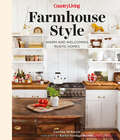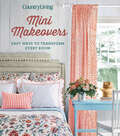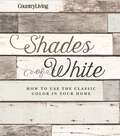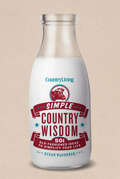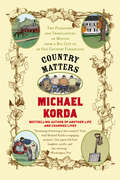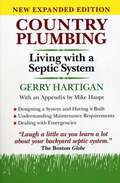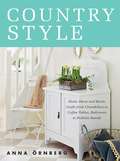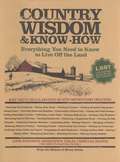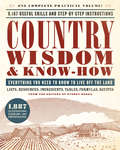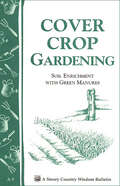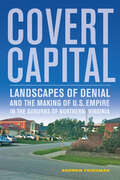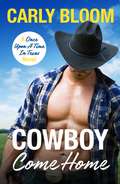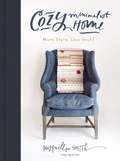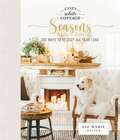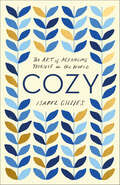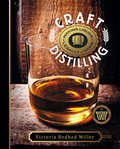- Table View
- List View
Country Living Farmhouse Style: Warm and Welcoming Rustic Homes
by Caroline McKenzieAdd rustic country charm and make home your favorite place to be. This collection of classic and modern farmhouses inspire easy and comfortable living. Farmhouse style is about cultivating connection, embracing the simple life, and bringing a kick-up-your-feet, linger-a-little-longer feeling to your home. Step inside 20 beautifully-designed homes and discover how to create the cozy and practical country vibe. An intimate look inside these homes reveals how designers blend elements of old and new and add a touch of distinctive character to every room. You&’ll tour a renovated New York farmhouse that pairs classic architecture with a fresh color palette for a hip yet historic look and discover how designer Lauren Leiss artfully refreshes a Virginia Colonial-style home with reclaimed floors and exposed beams. Plus, peek inside a ranch-style Texas home built from scratch which displays old-time charm inside and out. (Think: tons of textured cozy lived-in rooms featuring aged furniture and collections of time-worn books and oiled paintings.)Whether you are looking to upgrade your kitchen with an apron-front sink, add shiplap to your walls, or introduce flair to your living space with flea market finds, this expansive collection of farmhouses will inspire homeowners who plan to renovate or decorate a new home or make the perfect gift for anyone who dreams of a farmhouse of their own.
Country Living Mini Makeovers: Easy Ways to Transform Every Room
by Country LivingWhen it&’s time for a quick change, these 250 mini-makeovers for your home are fun and easy! No major remodeling necessary! Sometimes, all it takes are a few small changes to refresh your home and make you happy. These micro-decorating ideas from Country Living add beauty to every room, whether you&’re swapping your old coffee table for an antique bench, creating an eye-catching display in a passageway, or energizing your bedroom by playing with different patterns. You&’ll discover new possibilities for things to do, make, buy, and repurpose, and every chapter shows how to revive any space, from living and dining rooms to entryways, mudrooms, home offices, and porches. These fun mini-decorating moves can be as simple as selecting a dark wall color to cozy up a bedroom, showcasing vintage mirrors in the bathroom, or covering stair risers with whimsical floral wallpaper. You&’ll also find projects like decoupaging a dresser or tricking out a plain kitchen screen door—and most of them can be done in just one weekend. Pack a punch with simple switches for any space!Transform any room—one easy, inspirational idea at a time.
Country Living Shades of White: How to Use the Classic Color in Your Home
by Country LivingGet white right! Country Living offers a fresh new view on classic white, with its many variations and ability to transform any room. White is the ultimate color in country-style decorating—so of course Country Living has the ultimate take on white! Organized by design style (rustic, traditional, antique, and modern), the book&’s inviting images help you choose the right shade of white for any room—from delicate dove greys to tints with a pearly sheen and more. Whether you&’re on the hunt for just the right shade for your décor, a sturdy shade that can stand up to a busy family, a new way to warm up a blank wall, or a white that holds its own in classic color combos like red and white, blue and white, and black and white, Country Living provides the inspiration you need. &“Bright Idea&” tips throughout showcase design elements like beadboard cabinets, stone sinks, and even pops of color, and explain how each works to drive the overall neutral décor. Plus, do-it-yourself tips like &“Paint it!&” &“Collect it!&” and &“Craft it!&” encourage readers to add homespun charm to their homes with easy mini makeovers or weekend projects. Chapters include: Why White, Getting White Right, Rustic White, Traditional White, Antique White, Modern White, Country Combos, The Bucket List: 25 No-Fail Paint Colors
Country Living Simple Country Wisdom: 501 Old-Fashioned Ideas to Simplify Your Life
by Susan WaggonerHas life become a bundle of stress and mess? Top-selling author Susan Waggoner has the solution. This ingenious, fun-to-read illustrated guide--newly in paperback--offers tried-and-true household hints and practical solutions to everyday problems, from the &“A-to-Z Guide to Food&” to &“The Tao of Laundry.&” Whether its a no-scrub trick to make bathroom faucets gleam or surefire advice on keeping your house harmonious with as little fuss as possible, Country Living Simple Country Wisdom is the key to creating a home thats cheerful, welcoming, and warm. Practicing the domestic arts—housekeeping, baking, and tending the garden—allows us to create a warm and welcoming home and to achieve a profound sense of contentment. Now Simple Country Wisdom offers a treasure trove of advice for slowing down and keeping house the old-fashioned way, whether you live in the city, suburbs, or a rural community. Common sense suggestions handed down over generations are gathered in one place, all grounded in the do-it-yourself spirit of traditional country living. Making windows sparkle, giving floors a beautiful polish, and tidying up clutter aren&’t chores; they are the age-old rituals that help us create a home that&’s comfortable and charming. Simple Country Wisdom offers countless ideas for creating rooms that feel fresh, from big-picture cleaning to the little things that add a special touch, such as bed sheets hung to dry in the sun to acquire a fragrant outdoor scent. Tips such as how to season a cast-iron pan (even the one you inherited from your mom needs occasional re-seasoning) or prepare a guest room for the holidays are loving presented. The A-to-Z of Food offers invaluable information, like the secrets to whipping up the very best mashed potatoes and ripening a green tomato, while the baking chapter&’s rustic tips will inspire you to discover the joy of making the perfect pie or a creamy cheesecake. What could be more tranquil than puttering in the garden? Here you&’ll find wise advice for cultivating a thriving oasis that will attract birds and butterflies, perfect for reading, daydreaming, and entertaining outdoors. It&’s all designed to hand you the ideas you need to care for your home with as little fuss as possible. Country LivingSimple Country Wisdom will help you simplify your home and still have the time to enjoy it to the fullest.
Country Living Tiny Homes: Living Big in Small Spaces
by Country LivingBigger isn&’t always better: Country Living offers a look inside more than 25 tiny homes that maximize function and style. Downsizing has become a big trend—and many people are choosing to live small and smart in compact houses that don&’t require huge mortgages or upkeep. Country Living showcases a coast-to-coast collection of sustainable dwellings, all ranging from 100 to 1,500 square feet. Take an inside tour of these impressive little abodes, like a converted 1840s schoolhouse in New York, a 22- x 24-foot kit barn in California wine country, a 1914 New Hampshire coastal row home, and a renovated 1950s Alabama lake house. Along with inspiring photographs, hundreds of decorating tips, smart finds, and storage solutions will help you implement minimalistic living in your own home. These charming cottages, delightful she-sheds, functional farmhouses, and transformative trailers feature a clever use of space and prove that going small can be simple and fulfilling.
Country Matters
by Michael KordaWith his inimitable sense of humor and storytelling talent, New York Times bestselling author Michael Korda brings us this charming, hilarious, self-deprecating memoir of a city couple's new life in the country.At once entertaining, canny, and moving, Country Matters does for Dutchess County, New York, what Under the Tuscan Sun did for Tuscany. This witty memoir, replete with Korda's own line drawings, reads like a novel, as it chronicles the author's transformation from city slicker to full-time country gentleman, complete with tractors, horses, and a leaking roof.When he decides to take up residence in an eighteenth-century farmhouse in Dutchess County, ninety miles north of New York City, Korda discovers what country life is really like:Owning pigs, more than owning horses, even more than owning the actual house, firmly anchored the Kordas as residents in the eyes of their Pleasant Valley neighbors. You may own your land, but without concertina barbed wire, or the 82nd Airborne on patrol, it's impossible to keep people off it! It's possible to line up major household repairs over a tuna melt sandwich. And everyone in the area is fully aware that Michael "don't know shit about septics." The locals are not particularly quick to accept these outsiders, and the couple's earliest interactions with their new neighbors provide constant entertainment, particularly when the Kordas discover that hunting season is a year-round event -- right on their own land! From their closest neighbors, mostly dairy farmers, to their unforgettable caretaker Harold Roe -- whose motto regarding the local flora is "Whack it all back! " -- the residents of Pleasant Valley eventually come to realize that the Kordas are more than mere weekenders. Sure to have readers in stitches, this is a book that has universal appeal for all who have ever dreamed of owning that perfect little place to escape to up in the country, or, more boldly, have done it.
Country Matters
by Michael Korda Success Research CorWith his inimitable sense of humor and storytelling talent, New York Times bestselling author Michael Korda brings us this charming, hilarious, self-deprecating memoir of a city couple's new life in the country.At once entertaining, canny, and moving, Country Matters does for Dutchess County, New York, what Under the Tuscan Sun did for Tuscany. This witty memoir, replete with Korda's own line drawings, reads like a novel, as it chronicles the author's transformation from city slicker to full-time country gentleman, complete with tractors, horses, and a leaking roof.When he decides to take up residence in an eighteenth-century farmhouse in Dutchess County, ninety miles north of New York City, Korda discovers what country life is really like:Owning pigs, more than owning horses, even more than owning the actual house, firmly anchored the Kordas as residents in the eyes of their Pleasant Valley neighbors. You may own your land, but without concertina barbed wire, or the 82nd Airborne on patrol, it's impossible to keep people off it! It's possible to line up major household repairs over a tuna melt sandwich. And everyone in the area is fully aware that Michael "don't know shit about septics."The locals are not particularly quick to accept these outsiders, and the couple's earliest interactions with their new neighbors provide constant entertainment, particularly when the Kordas discover that hunting season is a year-round event -- right on their own land! From their closest neighbors, mostly dairy farmers, to their unforgettable caretaker Harold Roe -- whose motto regarding the local flora is "Whack it all back! " -- the residents of Pleasant Valley eventually come to realize that the Kordas are more than mere weekenders.Sure to have readers in stitches, this is a book that has universal appeal for all who have ever dreamed of owning that perfect little place to escape to up in the country, or, more boldly, have done it.
Country Matters
by Michael Korda Success Research CorWith his inimitable sense of humor and storytelling talent, New York Times bestselling author Michael Korda brings us this charming, hilarious, self-deprecating memoir of a city couple's new life in the country.At once entertaining, canny, and moving, Country Matters does for Dutchess County, New York, what Under the Tuscan Sun did for Tuscany. This witty memoir, replete with Korda's own line drawings, reads like a novel, as it chronicles the author's transformation from city slicker to full-time country gentleman, complete with tractors, horses, and a leaking roof.When he decides to take up residence in an eighteenth-century farmhouse in Dutchess County, ninety miles north of New York City, Korda discovers what country life is really like:Owning pigs, more than owning horses, even more than owning the actual house, firmly anchored the Kordas as residents in the eyes of their Pleasant Valley neighbors. You may own your land, but without concertina barbed wire, or the 82nd Airborne on patrol, it's impossible to keep people off it! It's possible to line up major household repairs over a tuna melt sandwich. And everyone in the area is fully aware that Michael "don't know shit about septics."The locals are not particularly quick to accept these outsiders, and the couple's earliest interactions with their new neighbors provide constant entertainment, particularly when the Kordas discover that hunting season is a year-round event -- right on their own land! From their closest neighbors, mostly dairy farmers, to their unforgettable caretaker Harold Roe -- whose motto regarding the local flora is "Whack it all back! " -- the residents of Pleasant Valley eventually come to realize that the Kordas are more than mere weekenders.Sure to have readers in stitches, this is a book that has universal appeal for all who have ever dreamed of owning that perfect little place to escape to up in the country, or, more boldly, have done it.
Country Matters
by Michael Korda Success Research CorWith his inimitable sense of humor and storytelling talent, New York Times bestselling author Michael Korda brings us this charming, hilarious, self-deprecating memoir of a city couple's new life in the country.At once entertaining, canny, and moving, Country Matters does for Dutchess County, New York, what Under the Tuscan Sun did for Tuscany. This witty memoir, replete with Korda's own line drawings, reads like a novel, as it chronicles the author's transformation from city slicker to full-time country gentleman, complete with tractors, horses, and a leaking roof.When he decides to take up residence in an eighteenth-century farmhouse in Dutchess County, ninety miles north of New York City, Korda discovers what country life is really like:Owning pigs, more than owning horses, even more than owning the actual house, firmly anchored the Kordas as residents in the eyes of their Pleasant Valley neighbors. You may own your land, but without concertina barbed wire, or the 82nd Airborne on patrol, it's impossible to keep people off it! It's possible to line up major household repairs over a tuna melt sandwich. And everyone in the area is fully aware that Michael "don't know shit about septics."The locals are not particularly quick to accept these outsiders, and the couple's earliest interactions with their new neighbors provide constant entertainment, particularly when the Kordas discover that hunting season is a year-round event -- right on their own land! From their closest neighbors, mostly dairy farmers, to their unforgettable caretaker Harold Roe -- whose motto regarding the local flora is "Whack it all back! " -- the residents of Pleasant Valley eventually come to realize that the Kordas are more than mere weekenders.Sure to have readers in stitches, this is a book that has universal appeal for all who have ever dreamed of owning that perfect little place to escape to up in the country, or, more boldly, have done it.
Country Matters
by Michael Korda Success Research CorWith his inimitable sense of humor and storytelling talent, New York Times bestselling author Michael Korda brings us this charming, hilarious, self-deprecating memoir of a city couple's new life in the country.At once entertaining, canny, and moving, Country Matters does for Dutchess County, New York, what Under the Tuscan Sun did for Tuscany. This witty memoir, replete with Korda's own line drawings, reads like a novel, as it chronicles the author's transformation from city slicker to full-time country gentleman, complete with tractors, horses, and a leaking roof.When he decides to take up residence in an eighteenth-century farmhouse in Dutchess County, ninety miles north of New York City, Korda discovers what country life is really like:Owning pigs, more than owning horses, even more than owning the actual house, firmly anchored the Kordas as residents in the eyes of their Pleasant Valley neighbors. You may own your land, but without concertina barbed wire, or the 82nd Airborne on patrol, it's impossible to keep people off it! It's possible to line up major household repairs over a tuna melt sandwich. And everyone in the area is fully aware that Michael "don't know shit about septics."The locals are not particularly quick to accept these outsiders, and the couple's earliest interactions with their new neighbors provide constant entertainment, particularly when the Kordas discover that hunting season is a year-round event -- right on their own land! From their closest neighbors, mostly dairy farmers, to their unforgettable caretaker Harold Roe -- whose motto regarding the local flora is "Whack it all back! " -- the residents of Pleasant Valley eventually come to realize that the Kordas are more than mere weekenders.Sure to have readers in stitches, this is a book that has universal appeal for all who have ever dreamed of owning that perfect little place to escape to up in the country, or, more boldly, have done it.
Country Matters
by Michael Korda Success Research CorWith his inimitable sense of humor and storytelling talent, New York Times bestselling author Michael Korda brings us this charming, hilarious, self-deprecating memoir of a city couple's new life in the country.At once entertaining, canny, and moving, Country Matters does for Dutchess County, New York, what Under the Tuscan Sun did for Tuscany. This witty memoir, replete with Korda's own line drawings, reads like a novel, as it chronicles the author's transformation from city slicker to full-time country gentleman, complete with tractors, horses, and a leaking roof.When he decides to take up residence in an eighteenth-century farmhouse in Dutchess County, ninety miles north of New York City, Korda discovers what country life is really like:Owning pigs, more than owning horses, even more than owning the actual house, firmly anchored the Kordas as residents in the eyes of their Pleasant Valley neighbors. You may own your land, but without concertina barbed wire, or the 82nd Airborne on patrol, it's impossible to keep people off it! It's possible to line up major household repairs over a tuna melt sandwich. And everyone in the area is fully aware that Michael "don't know shit about septics."The locals are not particularly quick to accept these outsiders, and the couple's earliest interactions with their new neighbors provide constant entertainment, particularly when the Kordas discover that hunting season is a year-round event -- right on their own land! From their closest neighbors, mostly dairy farmers, to their unforgettable caretaker Harold Roe -- whose motto regarding the local flora is "Whack it all back! " -- the residents of Pleasant Valley eventually come to realize that the Kordas are more than mere weekenders.Sure to have readers in stitches, this is a book that has universal appeal for all who have ever dreamed of owning that perfect little place to escape to up in the country, or, more boldly, have done it.
Country Plumbing: Living with a Septic System
by Gerry HartiganYou can keep your septic system running day-after-day, year after-year. First published in 1984, Country Plumbing, in its initial edition, went through eight printings and has educated and entertained thousands of country dwellers who live beyond the reach of public sewer systems. Now, with the contribution of Mike Haupt, this revised edition contains information about some of the more recent developments in the world of private sewage treatment facilities. Even in restricted areas such as lakeside properties or small lots, you can live without a public sewer hook-up and still be a good steward of the environment.
Country Style: Home Décor and Rustic Crafts from Chandeliers to Coffee Tables, Bedcovers to Bulletin Boards
by Anna ÖrnbergA beautiful, rustic home isn't hard to create. With a splash of color, some pieces that pop, and a little bit of inspiration, even the most standard unit can be flipped into a country haven. Try elegant whites, industrial details, grandiose patterns, or some shabby chic. It's fun, easy to accomplish, and the results will make you proud. Liven up your space with such projects as: Vintage silhouette art Antique book decor Military bed covers Door frame bulletin boards Wallpapering, crocheting, decoupage, and more!So take a quick trip to the flea market, the thrift store, or even the attic-it'll trigger the impulse to decorate! Plus, crafting and decorating is the best form of stress-relief. Paint, sew, sand, sculpt-work with your hands to clear your mind and make your home beautiful in the process. Featuring patterns, step by steps, and over 100 photos, Country Style is the perfect how-to for decorators of all experience levels and with any type of home.
Country Wisdom & Know-How: Everything You Need to Know to Live Off the Land
by Editors of Storey BooksReminiscent in both spirit and design of the beloved Whole Earth Catalog, Country Wisdom & Know-How is an unprecedented collection of information on nearly 200 individual topics of country and self-sustained living. Compiled from the information in Storey Publishing's landmark series of "Country Wisdom Bulletins," this book is the most thorough and reliable volume of its kind. Organized by general topic including animals, cooking, crafts, gardening, health and well-being, and home, it is further broken down to cover dozens of specifics from "Building Chicken Coops" to "Making Cheese, Butter, and Yogurt" to "Improving Your Soil" to "Restoring Hardwood Floors." Nearly 1,000 black-and-white illustrations and photographs run throughout and fascinating projects and trusted advice crowd every page.
Country Wisdom & Know-How: Everything You Need to Know to Live Off the Land
by Storey Publishing's Country Wisdom BulletinsReminiscent in both spirit and design of the beloved Whole Earth Catalog, Country Wisdom & Know -How is an unprecedented collection of information on nearly 200 individual topics of country and self-sustained living.Compiled from the information in Storey Publishing's landmark series of "Country Wisdom Bulletins," this book is the most thorough and reliable volume of its kind.Organized by general topic including animals, cooking, crafts, gardening, health and well-being, and home, it is further broken down to cover dozens of specifics from "Building Chicken Coops" to "Making Cheese, Butter, and Yogurt" to "Improving Your Soil" to "Restoring Hardwood Floors." Nearly 1,000 black-and-white illustrations and photographs run throughout and fascinating projects and trusted advice crowd every page.
Cover Crop Gardening: Soil Enrichment With Green Manures/Storey's Country Wisdom Bulletin A-05 (Storey Country Wisdom Bulletin Ser.)
by Editors of Storey PublishingGreen manuring – the growing and turning under of cover crops to fertilize and improve your soil – is one of the best things you can do for your garden. <P><P>This practice eliminates the need for chemical fertilizers and nitrogen, helps unlock nutrients in the soil, cuts down on weeds, increases the number of beneficial organisms in your soil, and improves your soil’s ability to hold water. <P><P>The result is that you spend less time, energy, and money while enjoying a healthier, more productive, and more attractive garden. This concise guide introduces you to the primary methods of green manuring and shows you how to select your cover crops, how to plant them, and when and how to turn them under.
Covered Bridges in China
by China Highway &Transportation SocietyThis book is the first comprehensive work on Chinese covered bridges study, covering fields of human geography, historical buildings, and transportation. It includes more than 300 covered bridges of ancient and modern China, researching and analyzing their historical evolutions, architectural technologies and aesthetic values. And it, for the first time, divides Chinese covered bridges into “six covered bridge belts” and fills the academic gaps. This book presents an informative and splendid tour into covered bridges, illustrated and full of humanist consciousness. It targets on audience who works in transportation, human geography, historical buildings and Chinese traditional culture with its significant value both in academy and art.
Covering Ground: Unexpected Ideas For Landscaping With Colorful, Low-maintenance Ground Covers
by Barbara W. EllisGround covers are a pretty and practical way to bring diversity, elegance, and durability to open sweeps of lawn. Give your landscape a vibrant new palette that is both sustainable and low-maintenance through plantings of herbs, shrubs, mosses, and more. Barbara W. Ellis provides a variety of full-color lawn designs and professional planting advice to get you started. You’ll be amazed as your ordinary lawn transforms into a striking display of color and texture.
Covert Capital: Landscapes of Denial and the Making of U.S. Empire in the Suburbs of Northern Virginia (American Crossroads)
by Andrew FriedmanThe capital of the U.S. Empire after World War II was not a city. It was an American suburb. In this innovative and timely history, Andrew Friedman chronicles how the CIA and other national security institutions created a U.S. imperial home front in the suburbs of Northern Virginia. In this covert capital, the suburban landscape provided a cover for the workings of U.S. imperial power, which shaped domestic suburban life. The Pentagon and the CIA built two of the largest office buildings in the country there during and after the war that anchored a new imperial culture and social world. As the U.S. expanded its power abroad by developing roads, embassies, and villages, its subjects also arrived in the covert capital as real estate agents, homeowners, builders, and landscapers who constructed spaces and living monuments that both nurtured and critiqued postwar U.S. foreign policy. Tracing the relationships among American agents and the migrants from Vietnam, El Salvador, Iran, and elsewhere who settled in the southwestern suburbs of D.C., Friedman tells the story of a place that recasts ideas about U.S. immigration, citizenship, nationalism, global interconnection, and ethical responsibility from the post-WW2 period to the present. Opening a new window onto the intertwined history of the American suburbs and U.S. foreign policy, Covert Capital will also give readers a broad interdisciplinary and often surprising understanding of how U.S. domestic and global histories intersect in many contexts and at many scales.American Crossroads, 37
Cowboy Come Home: A steamy, wild ride for any modern romance lover! (Once Upon A Time In Texas #2)
by Carly BloomCowboy Come Home is Carly Bloom's new sexy Western romance. Perfect for fans of Harper Sloan, Kelly Elliott, Diana Palmer, Jennifer Ryan and Jessica Clare.Welcome to Big Verde, Texas, where a love-'em-and-leave-'em cowboy faces his greatest challenge yet - the woman he left behind. 'As always, Bloom's writing is hilarious, steamy, and really sweet' 5* review 'Honestly, I didn't want this book to end' 5* review 'Cowboy Come Home, just like its predecessor, is a romance for modern readers....I cannot wait for the next one!' 5* reviewSome cowboys aren't cut out to be Prince Charming - and Claire Kowalski knows that better than anyone. She gave her heart to Ford Jarvis two years ago, yet that didn't keep him from disappearing into the sunset. Now that he's back in Big Verde, Texas, she's determined not to make the same mistake twice. But the ruggedly sexy cowboy still knows how to push all her buttons, and avoiding him is nearly impossible when she needs his help.Ford didn't plan on returning home - ever - but when he hears that the Kowalski ranch is in trouble, he hightails it back to town. He's not eager to be reminded of the life he can never have, but his time in Big Verde is only temporary. He'll stay long enough to get the ranch up and running, then hit the road again. But when Ford finds out the new foreman he's training is Claire, still as stubborn and beautiful as ever, this cowboy is going to have to decide what matters most - repeating the mistakes of the past or fighting for a future with the only woman he's ever loved.*Includes Rocky Mountain Cowboy, a novella by Sara Richardson*Look out for more Once Upon a Time in Texas westerns, including Big Bad Cowboy, out now!Praise for Carly Bloom and Big Bad Cowboy:'Sexy, smart, sensational!' Lori Wilde, New York Times bestselling author 'Big Bad Cowboy is sweet and sexy!' Jennifer Ryan, New York Times bestselling author 'Fans of Susan Elizabeth Phillips will delight in this funny, optimistic, quirky contemporary' Publishers Weekly, starred review
Cozy Minimalist Home: More Style, Less Stuff
by Myquillyn SmithMore Style, Less StuffCozy Minimalism isn’t about going without or achieving a particular new, modern style. Nope. It’s simply a mindset that helps you get whatever style YOU LOVE with the fewest possible items.You want a warm, cozy, inviting home, without using more resources, money, and stuff than needed. Why use more if you don't have to?In Cozy Minimalist Home, accidental stylist and bestselling author Myquillyn Smith guides you step by step on making purposeful design decisions for your home. You'll have the tools to transform your home starting with what you already have, and using just enough of the right furniture and decor to create a home you're proud of in a way that honors your personal priorities, budget, and style. No more fretting when it comes to decorating your house! In Cozy Minimalist Home, Myquillyn Smith helps youRealize your role as the curator of your home who makes smart, style-impacting design choicesFinally know what to focus on, and what not to worry about when it comes to your homeDiscover the real secret to finding your unique style—it has nothing to do with those style quizzesUnderstand how to find a sofa you won't hate tomorrowDeconstruct each room and then re-create it step by step with a fail proof processCreate a pretty home with more style and less stuff—resulting in backwards decluttering!Finish your home and have it looking the way you've always hoped so you can use it the way you've always dreamed After reading Myquillyn's first book, The Nesting Place, women everywhere were convinced that it doesn’t have to be perfect to be beautiful and they found real contentment in their homes. But how does a content imperfectionist make actual design decisions?Cozy Minimalist Home is the answer to that question. Written for the hands-on woman who'd rather move her own furniture than hire a designer, this is the guidance she needs to finish every room of her house. With people, priorities and purpose in mind, anyone can create a beautiful home that transcends the trends.A pretty home is nice, but a Cozy Minimalist home goes beyond pretty and sets the stage for connection, relationship, and rest.
Cozy White Cottage Seasons: 100 Ways to Be Cozy All Year Long (Perfect for People Who Love Interior Design, Decorating, DIY, Crafting, and Creating Inviting Spaces at Home) (Cozy White Cottage)
by Liz Marie GalvanThe perfect gift (or self-gift) to discover cozy home tips and hacks that will make Christmas and every season special.Whether you want to create a cozy winter wonderland in your living room, a blooming summertime welcome on your deck, or an autumn refuge by your fireplace, Liz Marie Galvan&’s Cozy White Cottage Seasons gives you the inspiring photos, DIY ideas, and fun recipes you need to feel at home on any budget and in every season.Do-it-yourself interior designer and popular blogger Liz Marie Galvan helps you create space to snuggle up, stretch out, or kick back at home so you can focus on what matters most during the holidays and every day. Following the popularity of Cozy White Cottage, Cozy White Cottage Seasons is a beautiful, full-color photography holiday lifestyle book with easy-to-do, practical tips to make your home a welcome haven—from New Year&’s Day to spring, summer, fall, and all the way through Christmas.Cozy White Cottage Seasons equips you to:Create cozy celebrations, traditions, and memories indoors and outRepurpose furniture and decor for every seasonCultivate your flair for vintage, modern, farmhouse, or a unique style all your ownDesign a hot cocoa bar—and make other seasonally cozy recipesStore and manage holiday clutterAnd so much more! In addition, you&’ll find fun ideas to celebrate and decorate for: Christmas Thanksgiving Halloween Fourth of July Father&’s Day and Mother&’s Day Easter Valentine&’s Day And any special gatherings Cozy White Cottage Seasons is a great gift for Christmas, birthdays, and Mother&’s Day or as a beautiful yet practical housewarming gift.A cozy enthusiast living in an 1800s farmhouse, Liz&’s design tips and wisdom have been featured on the TODAY show, Better Homes and Gardens, and Country Living. With decorating tips, fun family traditions, and doable ways to make your home inviting in every season, Liz helps you create a beautiful living space and a grateful heart all year long.Look for Liz's other cozy home décor book full of DIY inspiration, Cozy White Cottage.
Cozy White Cottage: 100 Ways to Love the Feeling of Being Home (Cozy White Cottage)
by Liz Marie GalvanWhether you live in a country farmhouse or an urban apartment, find inspiration for every room in your home. Come cozy up with your creativity and Liz's welcoming voice so you can love the feeling of being at home. In this beautiful book of house and garden photography and DIY inspiration, popular blogger Liz Marie Galvan shares:100 tips and tricks to make your home feel cozyBudget-friendly hints to make decorating affordableSimple DIY projects for every room in your houseIn Cozy White Cottage, you'll get the help you need to create a space you love coming home to as Liz offers her best home décor and design tips. You'll love Liz's real-life, easy, and affordable ideas to get the most out of your home and discover things like:The passion and productivity that can pour out of an inspiring, functional workspace or home officeThe conversation and connection that flow out of a warm, well-arranged living roomThe thoughtful hospitality that can welcome guests, be it for a cup of coffee or an overnight stayThe rejuvenation that can happen when we have quiet spaces for reading, prayer, and restThe calming routines and rituals that we can implement into our spaces and our livesThe laughter, joy, and learning that can occur in adorable, functional playroomsThe life-giving power that beats in the heart of our homes: the kitchenJoin the hundreds of thousands of readers and DIY-ers who find design inspiration on Liz's blog, where she shares stories of life with her son, Cope, and veteran husband, Jose, in their 1800s Michigan farmhouse, and her home décor boutique. Cozy White Cottage offers inspiration for every style and makes the perfect self-purchase, housewarming gift, birthday treat, Mother's Day read, or holiday gift.Look for Liz&’s other cozy home décor book of DIY inspiration, Cozy White Cottage Seasons.
Cozy: The Art of Arranging Yourself in the World
by Isabel Gillies“Coziness is a state of mind” for the New York Times–bestseller of Happens Every Day, who has written a lifestyle guide as “a companion to Marie Kondo” (New York Times Book Review).When we talk about being cozy, most of us think of a favorite sweater or a steaming cup of tea on a rainy day. But to Isabel Gillies, coziness goes beyond mere objects. To be truly cozy, she argues, means learning to identify the innermost truth of yourself and carrying it into the world, no matter your environment.Starting when she was young, Gillies has gradually learned the art of creating a life where you feel safe, steadied, and at home in the world. In Cozy Gillies shows readers that true ease stems from opportunities to feel that we are part of something bigger than ourselves.Simple choices can make a hectic life or an uncomfortable situation just a little more comfortable—you just have to know what to do. Gillies offers a new way of occupying the spaces we live in. Written with profound warmth and featuring hand-drawn illustrations, this wise, necessary book is call to action for each of us to begin living a more intimate and authentic life.“Beautifully written with warmth and heart.” —Charles Duhigg, New York Times–bestselling author of The Power of Habit “Gillies blends first-person essays and travelogues, recipes, and tips to show that coziness [is] a way of looking at the world in a new light.” —Real Simple“A mashup of manifesto, lifestyle guide, memoir, observation, recipes. . . . Put it on the shelf next to your copy of The Little Book of Hygge, Marie Kondo, and The Happiness Project.” —Goop
Craft Distilling
by Victoria Redhed MillerMany people have experienced great success making their own beer or wine at home. In recent years a number of hobbyists have become interested in making distilled spirits. However, distilled spirits are more complicated to produce, and the process presents unique safety issues. In addition, alcohol distillation without a license is illegal in most countries, including the United States and Canada. From mashing and fermenting to building a small column still, Craft Distilling is a complete guide to creating high-quality whiskey, rum and more at home. Experienced brewer, distiller, and self- reliance expert Victoria Redhed Miller shares a wealth of invaluable information including: Quality Spirits 101: Step-by-step recipes and techniques Legal Liquor: An overview of the licensing process in the United States and Canada Raising the Bar: Advocacy for fair regulations for hobby distillersThis unique resource will show you everything you need to know to get started crafting top-quality spirits on a small scale - and do it legally. Sure to appeal to hobbyists, homesteaders, self-sufficiency enthusiasts, and anyone who cares about fine food and drink, Craft Distilling is the ideal offering for independent spirits. Victoria Redhed Miller is a writer, photographer and homesteader who lives on a forty-acre off-grid farm in northwest Washington State with her husband David. She strives to enhance her family's self-reliance through solar energy, gardening, food preservation, raising heritage poultry, blacksmithing, and other traditional skills Victoria is the author of Pure Poultry: Living Well with Heritage Chickens, Turkeys and Ducks.
